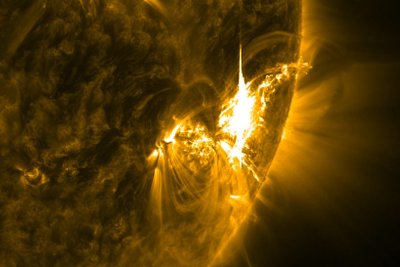**Moderate Solar Flare May Affect Earth’s Radio Communications on Wednesday**
A moderate solar flare might impact radio communications on Earth today, following a week of disruptions caused by two powerful solar flares. The National Oceanic and Atmospheric Administration (NOAA) has reported that this recent solar activity could influence radio signals in sunlit regions worldwide.
According to NOAA’s Space Weather Prediction Center, a moderate solar flare was recorded at 6:19 a.m. EST on Wednesday from the sun’s AR 4274 region. While this flare is weaker than the two reported on Tuesday, it produced a partial halo coronal mass ejection (CME) that could have some Earth-directed effects. NOAA added that this CME is currently under analysis to determine whether it poses a threat to Earth and what level of geomagnetic response might be anticipated.
On Tuesday, two larger solar flares caused significant radio disruptions across various regions. The first occurred at 12:34 p.m. EST from sunspot AR4274 and disrupted radio communications in most sunlit areas of North and South America, according to Space.com. The second flare, which was weaker, originated from a hidden area in the sun’s southeastern region at 5:02 p.m. It caused radio blackouts across sunlit areas of the North Pacific Ocean, New Zealand, and parts of eastern Australia.
Each of these solar flares released substantial plumes of magnetized plasma known as coronal mass ejections (CMEs). These particular ejections are not headed directly toward Earth; however, their outer edges could interact with fast-moving solar winds. Such interactions are predicted to potentially trigger geomagnetic storm conditions on Thursday and Friday.
Solar flares are intense eruptions of electromagnetic radiation from the sun. They can last from several minutes up to several hours. This sudden burst of energy travels at the speed of light, meaning it can affect sunlit regions on Earth almost immediately after eruption. During solar storms, geomagnetic activity can increase, often resulting in more vibrant auroras visible during nighttime hours, as noted by Space.com.
Stay tuned to space weather updates to understand any potential impacts on communication and navigation systems in the coming days.
https://www.upi.com/Science_News/2025/11/05/solar-flares/7371762369116/



